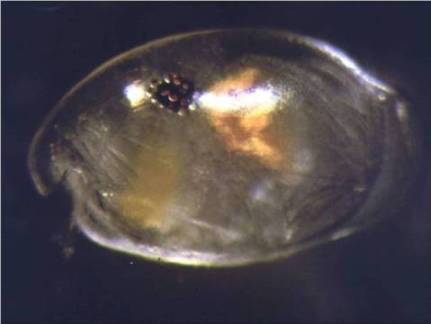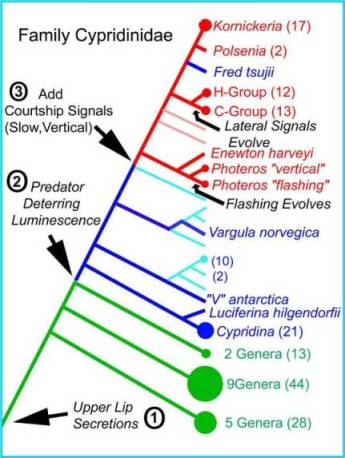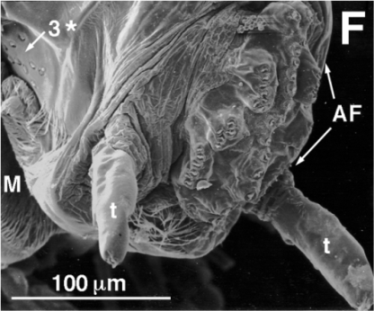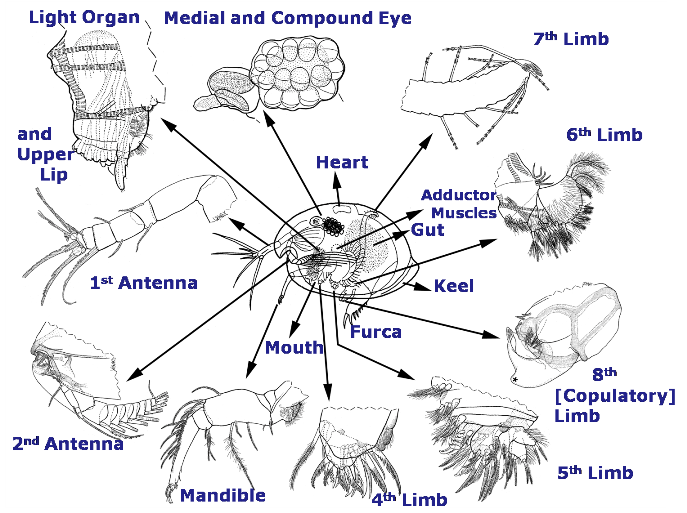Breaking it Down: The Taxonomic Classification of Photeros annecohenae
Domain: Eukarya
The word Eukarya contains the Latin roots "eu," meaning true, and "karya,"
meaning nut, or nucleus. Therefore, all members of this domain have
cells that each contain a true nucleus. These cells also contain
membrane-bound organelles.
Kingdom: Animalia
Photeros annecohenae are multicellular, heterotrophic (scavengers), lack a cell wall and,
therefore, are motile during at least one stage of their lifecycle (Ostracods
are motile as juveniles through adulthood.).

The above phylogenetic tree spans from the most broad
of taxa, domain, to a more exclusive classification, animal
phyla. It is based on comparative morphology and molecular data. The
phylogeny of Photeros annecohenae can be traced through
the tree by following the bolded lines and words.
Phylum: Arthropoda
Since
Photeros annecohenae are Arthropods, they display bilateral symmetry, have
segmented bodies, a chitinous exoskeleton, paired-jointed appendages
and grow via
molting. Arthropods also have a true, straight-through digestive system
(from mouth to anus) to
break down nutrients as well as an open circulatory system to
transport them. Other Arthropods include
spiders (including
tarantulas), scorpions, centipedes and all insects
(including
bees,
beetles,
mosquitoes,
mayflies and
dragonflies).
Subphylum: Crustacea
Crustaceans' bodies are divided into two distinct regions (tagmata):
the cephalothorax, which gives rise to the appendages, and the
abdomen, which contains the reproductive tissue and the
viscera. Members of this subphylum
also possess two pairs of antennae and mandibles.
Other Crustaceans include
lobsters, crayfish,
crabs and
barnacles.

Class: Ostracoda
Members of the class Ostracoda are separated from other
Crustaceans by a laterally compressed body, undifferentiated
head, seven or less limbs and a bivalved carapace with no growth
lines.
Subclass: Myodocopa
This group contains ostracods that are all marine species; the
other subclass, Podocopa, may live in freshwater or marine
environments. Myodocopa also brood
their eggs, while Podocopa deposit theirs. The compound
eyes of Myodocopa are more developed than those of the Podocopa in order to view and distinguish their own species' luminescent
courtship displays. (Members of the Podocopa do not
produce luminescent displays.)
Order: Myodocopida
The classification of Myodocopa is separated into two distinct
orders, Myodocopida and Halocyprida. Members of the Myodocopida
have a keel, while some members
of the Halocyprida have a spine-like structure. Also, there is
no known bioluminescence in the Halocyprida like there is in the
Myodocopida. The shape of the carapace also differs between the
two groups.
Family: Cypridinidae
Cypridinidae is the only family that contains species of which
males perform specific mating displays. This family contains 28
genera and more than 200 species (Morin 2001). 26 of these species are known
to be luminescent and have been named, but it is estimated that
there are 100 luminescent species of the family Cypridinidae out
there. All members of this family produce upper lip secretions,
but these secretions are not always used for bioluminescence. It
is important to note that not all members of the Cypridinidae
are bioluminescent. The family contains some species, such as
Photeros annecohenae, that use luminescence in
mating displays, some species
that use luminescence solely for predator deterrence and some
species that do not luminate whatsoever.
This phylogenetic tree
shows how Cypridinidae is separated into multiple
 genera! It is based
on morphological characteristics and limited DNA analysis.
The green section of the tree indicates genera of ostracod in
the family Cypridinidae that do not produce bioluminescence. The
blue section indicates genera that use
bioluminescence solely for predator deterrence and not in
courtship behaviors. Lastly, the red section of the tree,
including Photeros, separates the genera that use
bioluminescence for both defense from predators as well as
mating displays. The "C-Group" and "H-Group" of this section are
largely undescribed; in fact, species, and even genera,
classification of many bioluminescent ostracod groups are still under debate. There are many species
and genera left to be named and discovered. Molecular data has
just recently started to be used to change and support previous
phylogenies that have been based on morphology and display
behavior/bioluminescence (Gerrish Personal Communication).
genera! It is based
on morphological characteristics and limited DNA analysis.
The green section of the tree indicates genera of ostracod in
the family Cypridinidae that do not produce bioluminescence. The
blue section indicates genera that use
bioluminescence solely for predator deterrence and not in
courtship behaviors. Lastly, the red section of the tree,
including Photeros, separates the genera that use
bioluminescence for both defense from predators as well as
mating displays. The "C-Group" and "H-Group" of this section are
largely undescribed; in fact, species, and even genera,
classification of many bioluminescent ostracod groups are still under debate. There are many species
and genera left to be named and discovered. Molecular data has
just recently started to be used to change and support previous
phylogenies that have been based on morphology and display
behavior/bioluminescence (Gerrish Personal Communication).
Genus: Photeros (formerly Vargula)
The name of this genus refers to the organism’s ability to be
luminescent (to deter predators as well as produce mating
displays) (Gerrish Personal Communication). Aside from
morphological differences in limb shape between genera, members
of Photeros are designated by their pale color compared
to
other bioluminescent genera as well as the fact that they are
transparent (have no pigment in their valves or limbs).
 Species: Photeros annecohenae (formerly
Vargula annecohenae)
Species: Photeros annecohenae (formerly
Vargula annecohenae)
As mentioned above, the genus name Photeros refers to
the organism's ability to be luminescent. The species is named
for
Dr. Anne
C. Cohen.
Dr. Cohen is a systematist/taxonomist
who has carried out extensive research on Cypridinid ostracods.
The species Photeros annecohenae exhibits vertical
mating displays in the upward direction, and, like other species
of ostracod, may be distinguished by its specific
habitat as well.
The word "bioluminescent," of "bioluminescent
ostracod," obviously refers to the organim's ability to be luminescent.
"Ostracod"
stems from the Latin roots "ostrac," meaning shell, and "cod,"
meaning false imitation. This comes from the fact that an ostracod's "shell"/valves are a part
of its carapace, not an independent structure like in most
Arthropods.
Morphology:
These ostracods have a dorsally-hinged outer bivalve carapace
composed of chitin that entirely covers the extremities and
functions to protect the organism. They possess a simple medial eye
that detects light (extremely important since the organism is
dependent on dark for mating and food acquisition) as well as
 two
large compound lateral eyes that can judge distance as well as light
intensity. These compound eyes contain many
ommatidia that increase the complexity of the eye. The
evolution of these complex compound eyes is
crucial for their reproductive strategy. Members of Photeros
typically have seven pairs of appendages. The first pair, called the first antennae, act as sensory structures to
help the ostracod sense the environment and
allow males to grab and hold females during mating. The second pair
of appendages, the second antennae, with
setae, is primarily used for movement (swimming, crawling and
burrowing) (Morin 1986) but is also used for deciphering food sources from
other substances (Gerrish Personal Communication). These appendages are extended through a notch (called the
incisur) to allow for swimming. The furca
is a foot also used for swimming; it propels the ostracod along
the sediment (Gerrish Personal Communication). The
keel streamlines the organism and
helps it stay upright (Gerrish Personal Communication)
two
large compound lateral eyes that can judge distance as well as light
intensity. These compound eyes contain many
ommatidia that increase the complexity of the eye. The
evolution of these complex compound eyes is
crucial for their reproductive strategy. Members of Photeros
typically have seven pairs of appendages. The first pair, called the first antennae, act as sensory structures to
help the ostracod sense the environment and
allow males to grab and hold females during mating. The second pair
of appendages, the second antennae, with
setae, is primarily used for movement (swimming, crawling and
burrowing) (Morin 1986) but is also used for deciphering food sources from
other substances (Gerrish Personal Communication). These appendages are extended through a notch (called the
incisur) to allow for swimming. The furca
is a foot also used for swimming; it propels the ostracod along
the sediment (Gerrish Personal Communication). The
keel streamlines the organism and
helps it stay upright (Gerrish Personal Communication) . A mandible and maxillae are
present as well as an upper lip, on which three nozzles (See above
photo.) are located that secrete chemicals creating luminescence.
These chemicals are produced in a long,
curved gland called the
light organ. A pair of tusks is also present on the upper lip.
Male and female genitalia demonstrate a "lock and key"
morphology within a species, meaning the male genitalia of a Photeros
annecohenae only fits comfortably with the genitalia of a
female Photeros annecohenae. This is one reason mating
between species does not occur. Photeros annecohenae
are extremely small, reaching a maximum length of about two
millimeters. As stated on the Home page,
their valves contain no pigment and are, therefore, mostly
translucent.
. A mandible and maxillae are
present as well as an upper lip, on which three nozzles (See above
photo.) are located that secrete chemicals creating luminescence.
These chemicals are produced in a long,
curved gland called the
light organ. A pair of tusks is also present on the upper lip.
Male and female genitalia demonstrate a "lock and key"
morphology within a species, meaning the male genitalia of a Photeros
annecohenae only fits comfortably with the genitalia of a
female Photeros annecohenae. This is one reason mating
between species does not occur. Photeros annecohenae
are extremely small, reaching a maximum length of about two
millimeters. As stated on the Home page,
their valves contain no pigment and are, therefore, mostly
translucent.
Sexual dimorphism is evident primarily in the adult forms of Photeros annecohenae, especially in body size, eye size and
differences in the first antennae. The first antennae of males have
a grasping structure to hold females during mating. Males' first
antennae also has smaller suckers than the females'. Adult males are smaller
than adult females: Males average 1.62 millimeters in length, while
females average 2.02 millimeters in length (Torres and Morin 2007)). The carapace of females
is more rounded than that of males, and the lateral eyes of females
are 20% smaller than males’ (Torres and Morin 2007). The genital lobe (eighth limb) of
females is also a lot smaller than that of males and is unjointed.
The presence of this sexual dimorphism indicates
sexual selection (Morin and Cohen 2010).

Now that you know how Photeros annecohenae is classified
and how it may be identified morphologically, check out where the
species can be found in the world and what
habitat it occupies!
